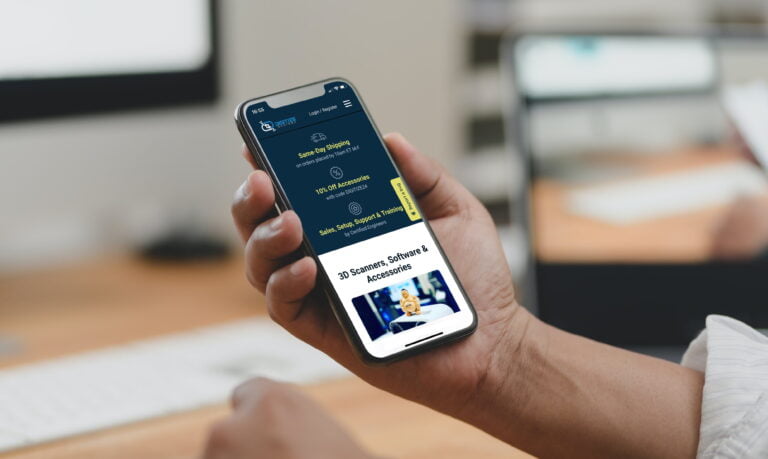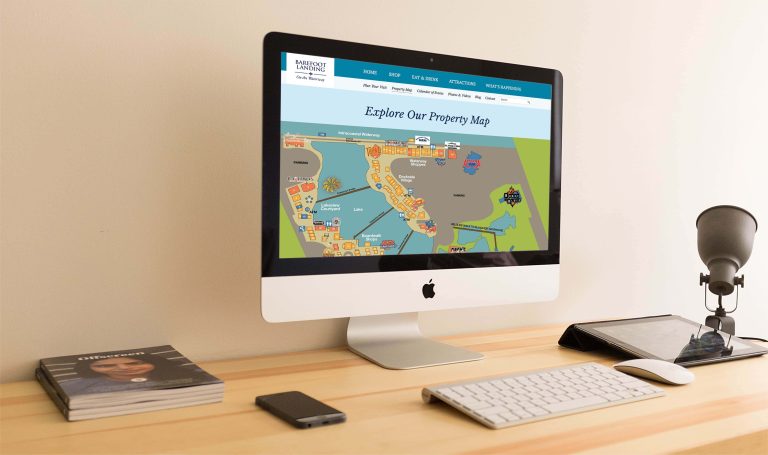
UX Design For an eCommerce Website
In the digital era, eCommerce has transformed how we shop, bringing products to our fingertips with just a few clicks. But what drives a successful online shopping experience? The effective eCommerce UX (User Experience) design for an eCommerce website provides customers a simple and intuitive journey.
It encompasses several elements, such as how quickly a page loads, the ease of navigating a website, and creating a seamless, engaging user experience. It starts from the moment they land on a website to the point of purchase and beyond.
This article delves into the various aspects of eCommerce UX design, including functionality, aesthetics, navigation, content, technical elements, and the user journey. We’ll understand how they shape a customer’s interaction with an online store.
What is eCommerce UX?
When it comes to film music, a saying goes, “If you don’t notice it, it’s good.” We can apply a similar principle to online shopping experiences. If navigating through an eCommerce web page makes them overthink, customers will likely abandon their purchase. In other words, if the shopping isn’t smooth and easy or requires too much effort, visitors may choose to shop elsewhere or not make the purchase at all.
Consider an example of an online clothing store where shoppers can
- Swiftly find a desired style jacket using an intuitive search function,
- View products in high-quality images and detailed descriptions,
- Easily navigate through size and color options,
- And go through a straightforward, no-stress checkout process.
Ideally, we have a steady-flowing customer journey from start to finish. Just like good film music that blends with the action on-screen, the shoppers’ intent and mental path blend with the conversion path provided by the website. No bottlenecks. No interruptions. To achieve that intuitive experience, we need to take care of multiple components of eCommerce UX design:
- Functionality
- Aesthetics
- Navigation
- Content
- Technical
- User Journey
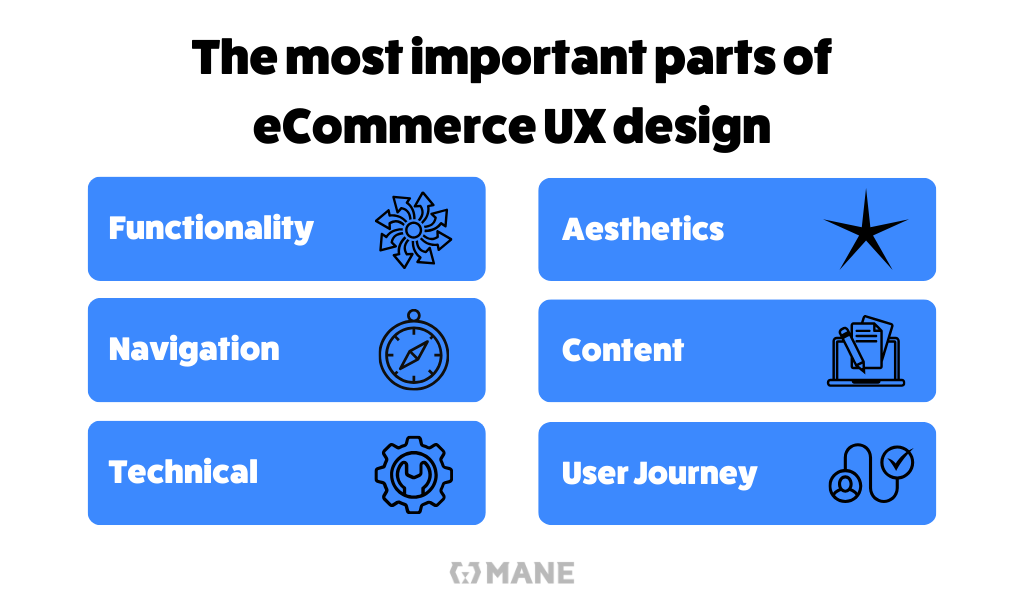
To better understand the art of eCommerce UX design, we will analyze each component in the following text and provide practical tips and examples.
Functionality and Aesthetics Go Hand-in-hand.
In eCommerce UX design, there is nothing more important than functionality. The fact is, first impressions matter, and a visually appealing page will draw users in. However, a functional design keeps customers engaged and enables consistent conversions.
Is there a more familiar example of function over style in eCommerce than Amazon? Amazon employs a clean layout with quality images and easy-to-read product information, enhancing visual appeal. It significantly improves the overall UX when paired with quick load times, smooth navigation, fast checkout, and next-day delivery.
Make Online Shopping Feel as Natural as Possible.
Traditional shopping provides an unmediated tactile experience. Also, visiting physical stores may instill more confidence. Is there a natural substitute for getting a suit tailored to your exact measures or wanting to feel the fabric under your fingers? That’s why online retailers try hard to compensate with different tech solutions or policies like hassle-free returns.
Utilize functional technology and advanced visuals.
While it’s still impossible to touch and feel items online, you can use technology to provide a more immersive experience. For instance, if you’re selling eyewear or jewelry, you can implement a virtual try-on feature on your page. If you’re selling furniture, you can use augmented reality to show customers how a piece would look in their home.
Other examples may include:
- High-Quality Imagery and Videos: Use high-resolution images and videos to showcase products from multiple angles.
- 360-Degree Product Views: Allow shoppers to see the item from all angles, just as they would when examining it in their hands.
- Virtual fitting rooms: For clothing, advanced AI algorithms can predict how clothes will fit based on a customer’s measurements and suggest the best size.
- Interactive Product Customization: Offer options for on-page customization, like choosing colors, materials, or components, with a live preview of their creation.
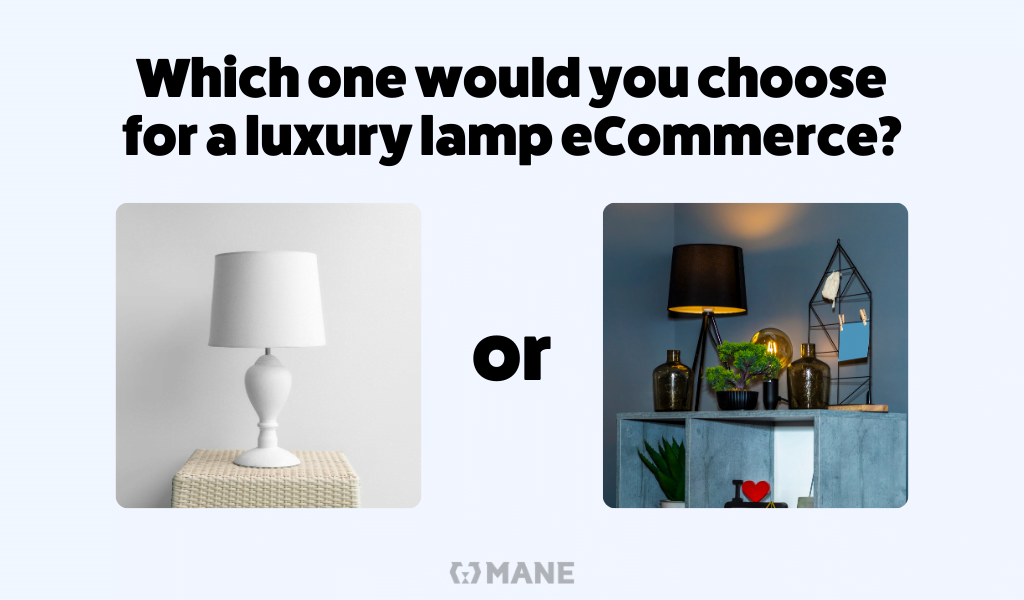
Beware of Too Many Flashy Features, Though
Dynamic design features like interactive elements, image sliders, and virtual/augmented reality features can help make the online buying experience more immersive and natural. The challenge is to implement them without seriously affecting the page loading speed. Skilled developers should be able to strike a balance between functionality and aesthetics. Therefore, choose them wisely.
Make eCommerce Store Navigation an Autopilot
The process should be effortless and intuitive when users browse your online store. It’s an unconscious process, much like walking into a convenience store where every item is on display and self-explanatory. Even the number of clicks is a non-issue as long as it’s automatic. The choices made by the users should lead to predictable outcomes.
Ensure your home page design provides easy access to your products, pages, and collections. The home page should be helpful rather than just visually attractive. It should anticipate the user’s needs as they scroll and click.
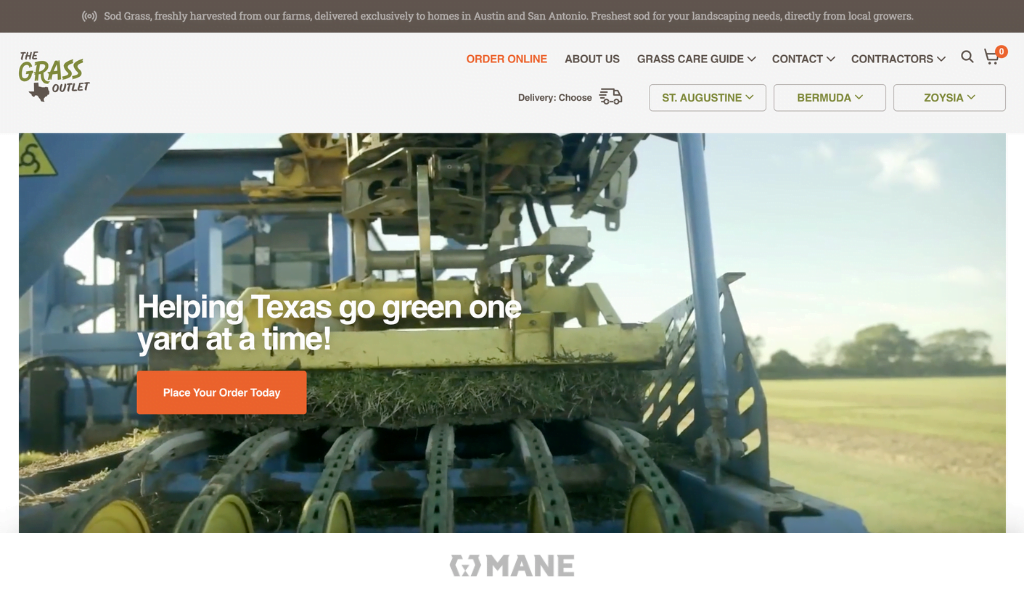
Useful Navigational Features to Implement on The Homepage
Not all visitors start their journey on the home page. Some could come to a specific landing page from an advertisement or a social media post. However, the home page is still your main storefront and a central hub for navigation, influencing the user’s journey on the site.
Implementing effective navigational features on the home page is crucial for providing a seamless and user-friendly buying experience. Here are eight useful navigational features to consider:
Clear and Concise Main Menu
The main menu should be prominently placed (typically at the top of the page) and easy to navigate. On the mobile version, in the form of a hamburger button and to the side. It should categorize the main product or service offerings, allowing shoppers to find what they’re looking for quickly. Dropdown menus make subcategories easily reachable and keep the interface clean and organized.
Search Bar with Advanced Features
A prominently placed search bar allows visitors to find specific items quickly, especially useful on mobile phones, where space is scarce. Enhancing it with features like auto-complete, search suggestions, and the ability to filter results can significantly improve UX. For more extensive catalogs, consider including options to search within specific categories.
High-Visibility Shopping Cart
The shopping cart icon should be easily accessible and visible at all times, ideally in the upper right corner of the page for both mobile and desktop. Indicating the number of items in the cart or showing a small preview of the cart’s contents on hover can be a helpful reminder to users.
Featured Products or Promotions
Use the home page to highlight featured products, new arrivals, bestsellers, or current promotions. It not only aids navigation but can also drive sales and showcase the range of products available.
Breadcrumbs
Breadcrumbs are a navigational aid that shows users their current location within the website’s hierarchy. They are helpful on eCommerce sites with multiple categories and subcategories, helping users easily navigate back to previous pages without using the browser’s back button.
Quick Links to Customer Service and Support
Provide easily accessible links to customer service and support resources, such as a ‘Contact Us’ page, live chat, support center, or FAQ section. These links can often be included in the header, footer, or as a floating button for easy accessibility, ensuring visitors can quickly find help.
Personalized Recommendations or Recently Viewed Products
Implementing a section for personalized product recommendations based on the user’s browsing history or a display of recently viewed products can enhance the shopping experience. This feature allows shoppers to return to products they have shown interest in easily, and it can also introduce them to new items aligned with their preferences.
Footer with Essential Links
Include a comprehensive footer that offers additional navigation options. It should contain links to important pages such as About Us, Contact Information, FAQs, Shipping and Return Policies, and Social Media links. The footer can help declutter the main menu while ensuring all necessary information is accessible.
These navigational features help make the buying experience more intuitive and efficient, reducing frustration and potentially increasing conversion rates. They also contribute to the overall usability and aesthetic appeal of the website.
Tailor Your Content to Fit Your Target Customers
Creating compelling copy for eCommerce UX combines creativity with strategy to deliver a message that clicks with the audience and motivates them to take action. The key is to find out exactly how your audience lives and breathes. Once you precisely define their personas, it is possible to push the right buttons using tailored content.
Again, good UX copywriting will completely sync with the customer’s state of mind and not provoke any reaction that might obstruct his journey and destimulate the purchase.
The key to building a successful eCommerce UX begins with comprehensive keyword research. It is also a point where UX meets SEO (Search Engine Optimization), as both methods interconnect and work together to elevate your site’s performance.
Keyword research shapes the content strategy, using specific keywords related to popular products. It can help structure and present product categories and descriptions, simplifying the process for users to find what they are looking for.
Copywriting Tips for Enhancing eCommerce UX
Try out these copywriting tips to create compelling content and enhance the UX of your online store:
- Know Your Audience: Tailor content to resonate with your target audience’s specific interests and needs.
- Craft Attention-Grabbing Headlines: Use captivating, clear headlines that promise value and encourage further reading.
- Use Active Voice and Emulate the Customer: Make your content direct and dynamic by consistently using an active voice that speaks in the tone of the target customer.
- Highlight Benefits, Not Just Features: Focus on how your products or services improve the customer’s life or solve their problems, include bullet points or pop-outs
- Be Clear and Concise: Use simple language and short sentences for easy understanding and readability, especially for the sake of the mobile version.
- Incorporate Storytelling: Connect emotionally with customers through engaging and relatable stories.
- Use Persuasive Elements: Employ techniques like social proof, scarcity, and exclusivity to motivate purchases.
- Include Strong Calls-to-Action: Guide users on their next steps with effective CTAs.
- Provide signposts: Guide users through the buying journey by including elements like breadcrumbs and progress indicators, and use language to explain where a link or a button leads.
- Write informative anchor text: Include links to relevant pages and include informative anchors.
- Use fewer words: Improve readability by carefully constructing phrases, being clear and concise, especially above the fold, and conveying your unique selling proposition and essential product information.
Include User-Generated Product Reviews
Genuine user reviews bring a host of benefits to the users as well as your website. It can save the user the time and effort required to research a product by displaying all the necessary information in one place, which can positively affect session duration, bounce rate, EEAT, SEO, and overall UX.
Therefore, including user-generated product reviews on an eCommerce site is beneficial for several reasons:
- Builds Trust and Credibility: Reviews from real customers add authenticity and credibility to your products, helping new users trust the quality and effectiveness of services or products you’re selling.
- Enhances Decision Making: Reviews provide valuable insights from other users’ experiences, aiding potential buyers in making informed purchasing decisions.
- Improves SEO: User-generated content can boost SEO as reviews often include keywords and fresh, regularly updated content that search engines favor.
- Increases Conversion Rates: Positive reviews can significantly influence buying behavior, increasing the likelihood of purchase as shoppers often rely on peer opinions.
- Provides Valuable Feedback: Reviews offer direct customer feedback about products, which you can use to improve product quality, address issues, and refine marketing strategies.
Take Care of Technical UX
Expert web developers are required to ensure satisfactory performance and conversion rates of eCommerce UX. Let’s take a look at some of the most important technical aspects:
Website Performance and Load Time
Online shopping is all about convenience and saving time. With many stores just a click away, customers expect a quick and hassle-free experience. Slow-loading pages test their patience and raise doubts about the store’s reliability, resulting in a potential loss of trust. Enhance load times by:
- Optimizing images
- Leveraging browser caching
- and minimizing HTTP requests
- Developing for mobile first
Fast-loading websites offer a smoother experience, encouraging visitors to stay longer and potentially increasing conversion rates.
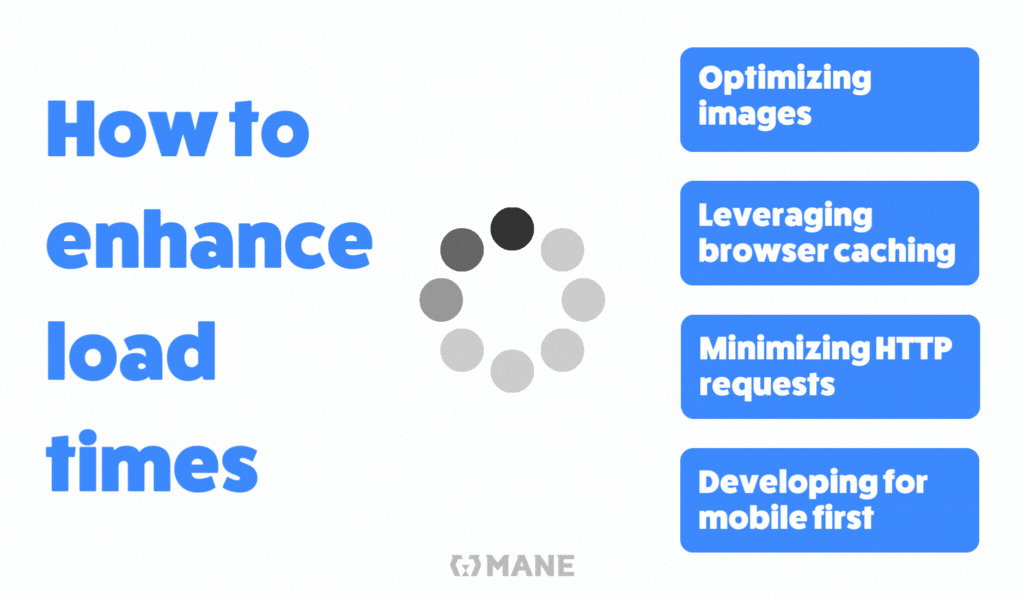
Mobile Responsiveness
Mobile responsiveness is essential, with a significant portion of today’s online shopping on mobile devices. An eCommerce site must function seamlessly across different devices and screen sizes, meaning:
- a flexible layout
- readable text without zooming
- accessible menus
- and touch-friendly elements.
Responsive design ensures consistent and satisfying buying experiences, regardless of the device used, which is vital for capturing the broadest possible audience. That’s why businesses should consider developing their eCommerce website’s mobile version first, then adapting it to the desktop version, etc.
Secure Payment Gateways
Ensuring the security of payment transactions is another crucial aspect of eCommerce UX. It instills a sense of trust in buyers and assures them that their sensitive information is safe and protected. This includes:
- Using encryption protocols like SSL for data protection
- Offering a variety of payment methods
- and Complying with PCI DSS standards.
A secure and smooth payment process also reduces cart abandonment and builds trust, encouraging repeat business.
Data Privacy and Security
In eCommerce UX design, safeguarding user data is of utmost importance. Upholding privacy and security involves adhering to regulations such as GDPR, using encryption methods, and protecting against data breaches. Transparent privacy policies and secure handling of user data enhance customer trust, making them feel more at ease while making transactions.
Scalability and Reliability
Scalability and reliability are crucial when handling peak traffic and sales periods for an eCommerce platform. It should be capable of scaling resources to meet the increasing demand without compromising performance. This kind of website’s ability is essential to ensure consistent shopping experiences during high-traffic events such as sales or holidays, which is vital for maintaining customer satisfaction and loyalty.
Accessibility Compliance
Accessibility in eCommerce UX means designing the website to be usable for people with disabilities. Following WCAG guidelines, such as providing text alternatives for non-text content, ensuring keyboard navigability, and offering sufficient contrast, makes the site more inclusive. An accessible website broadens the customer base and demonstrates a commitment to equality and social responsibility.
User Account Management
Efficient user account management features play a vital role in enhancing the eCommerce user experience. Such features include easy registration, login, and profile management, which offer shoppers personalized experiences. For instance, shoppers should be able to view their order history, track current orders, and manage personal information. Effective account management contributes to a more personalized and convenient shopping experience.
Integration with Inventory Management
Have you ever placed an order only to receive a message stating that the product is out of stock? Were you disappointed and hesitant to shop again? It is a common problem faced by customers. Real-time integration with inventory management systems plays a vital role in displaying accurate stock levels. This synchronization helps to prevent overselling and ensures users are not left disappointed. The reliability and efficiency of the eCommerce experience rise when your shop has accurate inventory information.
Utilize Funneling to Shape the User Journey and Influence UX
Strategic marketing and sales funnels are like connective tissue that binds all UX components together. They shape the eCommerce user journey by setting the structure for customer interaction at each stage.
Every step of the funnel, from creating awareness to fostering loyalty, should be enhanced by tailored UX strategies, ensuring customers have a consistent, engaging, and satisfying experience throughout their journey with the brand.
Let’s review an example sales funnel framework to see how eCommerce platforms can engage with customers at each stage.
Awareness and attraction
Potential customers often first encounter the brand through digital marketing efforts like social media advertising, SEO, content marketing, and email campaigns. At this stage, gear the UX towards creating a positive first impression, showcasing brand values, and highlighting product offerings. The ease of navigation, website aesthetics, and initial engagement determine whether a visitor will delve deeper or leave.
Interest and Engagement
Here, the UX becomes more interactive—an opportunity to present customers with detailed product information, engaging content, and personalized experiences. Use product filters, recommendation engines, and interactive content to enhance engagement. The goal is to make discovering and exploring products as intuitive and enjoyable as possible.
Consideration Stage
At this stage, potential customers are weighing their options. UX design is crucial in providing comprehensive product comparisons, customer reviews, and testimonials, which are vital in building trust and aiding decision-making. The accessibility, relevance, and clarity of information can significantly influence a customer’s purchase decision.
Streamlined Checkout Nails the Conversion.
Conversion is the critical point of the funnel. Here, UX focuses on simplifying the checkout process. A streamlined, secure, and efficient checkout experience is crucial. It involves features like transparent pricing, various payment options, minimal steps to purchase, and reassurance of transaction security. Any friction at this stage can lead to cart abandonment, making UX crucial for successful conversions.
Customer Retention and Advocacy
Last impressions can be more important than first. Post-purchase UX impacts how customers think and feel about their purchase and whether they come back and recommend your business to others. Employ follow-up emails, customer support, easy returns, and loyalty programs as part of the UX strategy to keep customers engaged and satisfied after their purchase.
Conclusion
ECommerce UX aims to provide a consistent, easy-to-use, and satisfying shopping experience that helps customers navigate and make informed decisions, ultimately leading to increased sales and overall satisfaction.
Each aspect of your website, including functionality, design, and technical capabilities, plays a significant role in determining the success of your online store.
It can be challenging to navigate this landscape alone, but you don’t have to.
MANE Digital specializes in eCommerce UX design, website design, and optimization and can create a tailored solution that aligns with your brand and target audience.
By partnering with MANE Digital, you’re not just improving your eCommerce business; you’re creating a memorable customer experience. Contact MANE Digital today to take your eCommerce game to the next level and turn your online store into a digital success story.

